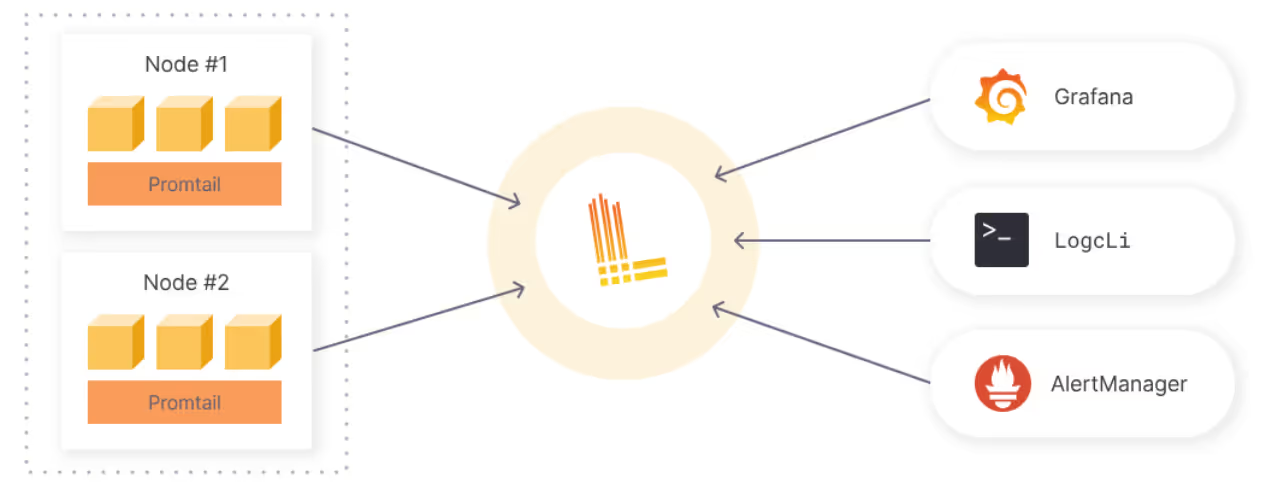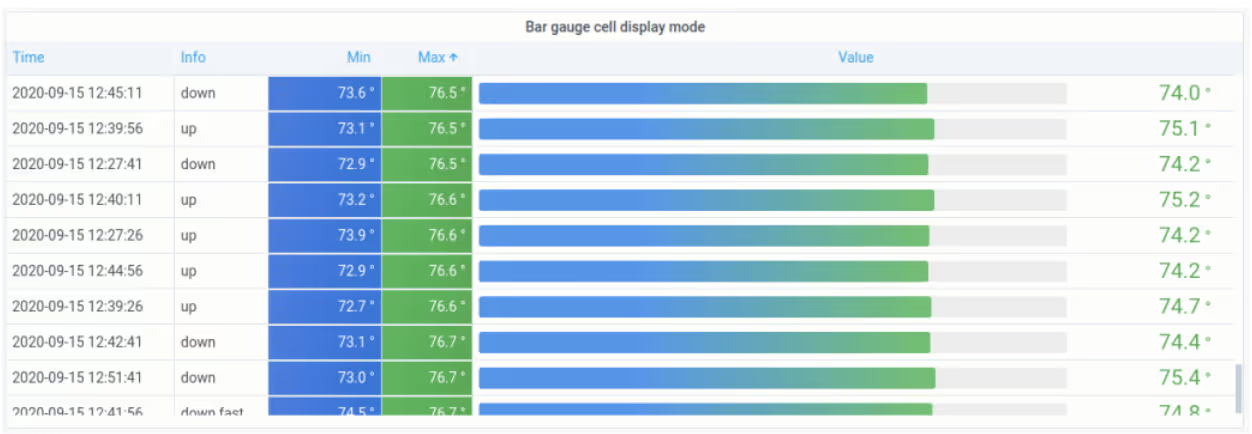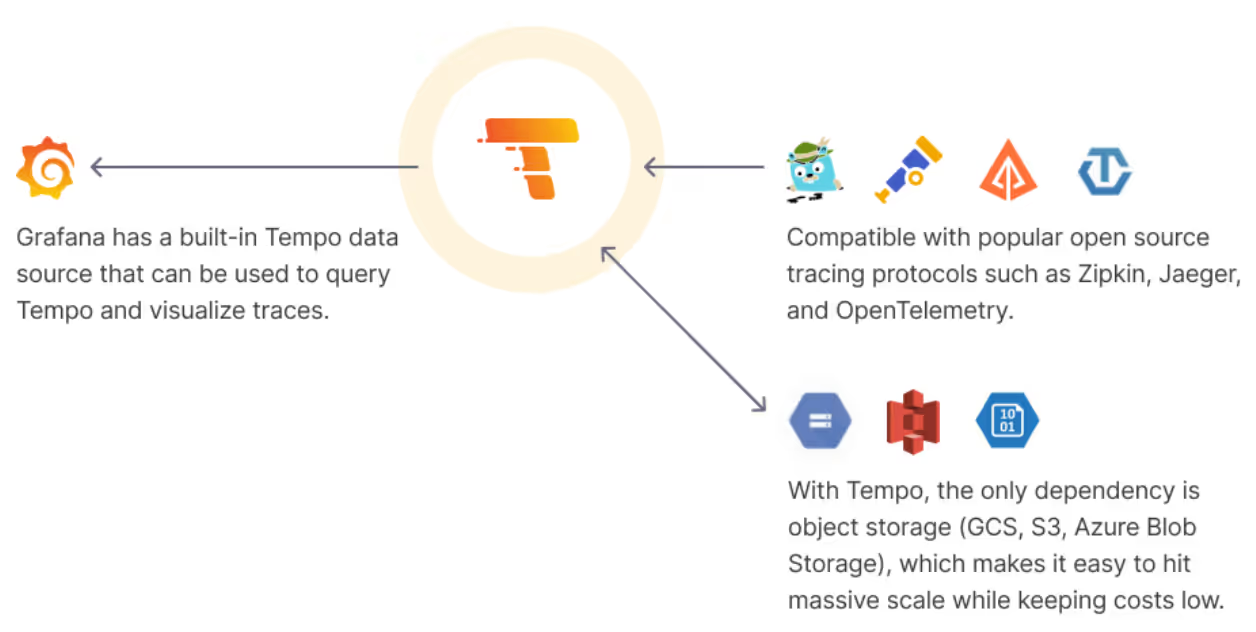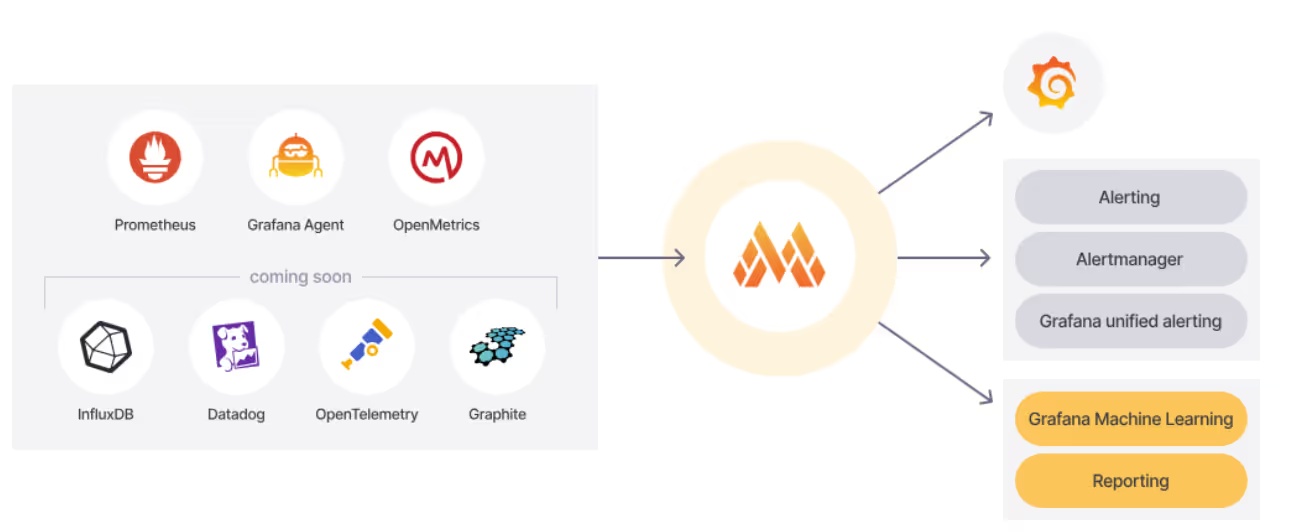The LGTM stack—Loki, Grafana, Tempo, and Mimir—is a comprehensive and open-source observability solution designed to simplify monitoring, debugging, and tracing in modern distributed systems.
Each component in the stack is purpose-built to address a key pillar of observability:
Together, the LGTM stack provides a unified framework to achieve robust observability, enabling organizations to diagnose and resolve performance issues efficiently.
The LGTM stack offers a unified, open-source ecosystem that integrates metrics, logs and traces into a single platform. This simplifies workflows and reduces complexity. Its open-source nature eliminates licensing fees, and its resource-efficient components make it a cost-effective choice.
Designed to scale seamlessly in modern cloud-native environments, LGTM is versatile enough to suit businesses of all sizes. Backed by Grafana and an active developer community, the stack evolves continually, addressing emerging challenges and ensuring long-term reliability.

This blog will not only provide your answers but also provide an in-depth look at the LGTM stack, detailing its components' roles and their alignment with the three pillars of observability.
We’ll explore its real-world benefits, including cost savings and operational efficiency, and provide actionable steps to implement and optimize LGTM for your observability needs. By the end, you’ll see how LGTM empowers organizations to improve monitoring, reduce downtime, and gain actionable insights.
The LGTM stack is built around four key components—Loki, Grafana, Tempo, and Mimir—each addressing a critical aspect of observability. Together, these tools provide a cohesive framework for monitoring, debugging, and tracing in distributed systems.
Below is a breakdown of each component, their features, and common use cases.

Loki serves as the centralized log aggregation solution, streamlining the collection and querying of application and system logs. Its schema-less architecture ensures flexibility, while its efficient storage design minimizes resource usage.
Loki is particularly useful for debugging, searching error logs, and tracking system events without the complexity of traditional log management systems.
Want to read more about Loki? Go through this doc.
GitHub Link: https://github.com/grafana/loki




Image Source: examples for how all the visualizations in Grafana look like.
Grafana is the visualization powerhouse of the stack, combining metrics, logs, and traces in customizable dashboards. With robust alerting capabilities and seamless integration with various data sources, Grafana enables real-time monitoring of system health and the creation of unified observability dashboards tailored to business needs.
Want to read more about Grafana for visualization? Go through this doc.
GitHub: https://github.com/grafana/grafana

Tempo simplifies distributed tracing by tracking requests across microservices, helping teams pinpoint issues in complex environments. It integrates with OpenTelemetry for standardized instrumentation and offers lightweight storage to keep infrastructure costs in check. Tempo excels in root cause analysis and mapping service dependencies, making it an essential tool for tracing.
Want to read more about Tempo? Read this Doc.
GitHub: https://github.com/grafana/tempo

Mimir is a scalable time-series database designed to handle massive volumes of metrics efficiently. With horizontal scalability and Prometheus compatibility, Mimir enables storing and querying performance metrics at scale. It’s an ideal solution for performance monitoring and long-term metric retention in distributed systems.
Want to know more? Go through this doc.
Mimir GitHub: https://github.com/grafana/mimir
When it comes to improving observability in your systems, the LGTM stack offers several advantages that can transform the way you monitor, debug, and optimize your infrastructure.
With the LGTM stack, you no longer need to juggle multiple tools for metrics, logs, and traces. Bringing everything together into a single platform simplifies workflows and ensures you have a complete view of your systems, making troubleshooting and analysis much more efficient.
Whether you’re managing a small application or a large distributed system, the LGTM stack scales effortlessly to meet your needs. Each component is designed to handle high volumes of data without compromising performance, making it a reliable choice as your system grows.
Because LGTM is built on open-source technologies, it helps you avoid hefty licensing fees while also using resource-efficient components to keep storage and operational costs low. It’s an excellent choice for teams looking to balance robust observability with budget constraints.
The stack’s flexibility allows you to integrate it with other tools in your ecosystem and adapt it to various use cases. Whether you’re troubleshooting microservices, monitoring system health, or analyzing performance trends, LGTM gives you the freedom to customize observability to suit your specific requirements.
Getting started with the LGTM stack involves deploying its components, configuring data sources, and building dashboards to make observability actionable and efficient.
Here's how you can set it up step by step:
You can deploy Loki, Grafana, Tempo, and Mimir using either Helm charts or Docker Compose, depending on your environment and scale. Helm charts are particularly effective for Kubernetes deployments, offering easy customization and scalability for cloud-native applications. If you’re testing locally or running a smaller setup, Docker Compose is a straightforward option for managing containers with minimal configuration. Ensure proper resource allocation for each component to maintain optimal performance as your data volume grows.
Once your components are up and running, link them to the relevant data sources to enable seamless integration:
Grafana serves as the visualization layer for the LGTM stack, enabling you to create unified dashboards that display metrics, logs, and traces in a single interface. Build dashboards tailored to your use case, such as system performance, application health, or specific error patterns.
To stay proactive, configure alerting rules for critical thresholds or patterns in metrics, logs, and traces. For instance, you can set alerts for resource spikes, error logs, or trace anomalies that indicate degraded performance. Alerts can be sent to tools like Slack, PagerDuty, or email to ensure timely responses.
This setup not only ensures seamless observability but also equips your team with the tools to monitor, debug, and optimize your systems efficiently.
To make the most out of the LGTM stack, implementing best practices ensures efficient usage, cost management, and improved observability outcomes.
Here’s how you can optimize your setup:
Managing storage effectively is key to keeping your observability stack cost-efficient and scalable. For logs and traces, use appropriate storage tiers based on data access patterns.
For example, keep recent data in faster storage for quick access while archiving older data in lower-cost storage solutions.
Additionally, retain only the data necessary for your analysis by setting retention policies. This approach not only saves resources but also avoids clutter in your observability workflows.
Instrumenting your applications with OpenTelemetry simplifies distributed tracing with Tempo. By standardizing the collection of trace data, OpenTelemetry ensures compatibility and consistency across your system.
Instrumentation enables you to track requests across services seamlessly, helping you pinpoint bottlenecks and troubleshoot faster. For new applications, prioritize instrumentation early in development to embed observability into your workflows from the start.
Use Grafana to unify metrics, logs, and traces into a single-pane-of-glass view. This centralization allows you to correlate data from different sources easily, providing a holistic understanding of your system’s health. Leverage Grafana’s ability to connect with additional data sources to expand your observability reach, enabling a comprehensive view of all critical components in your infrastructure.
Following these practices ensures that your LGTM stack remains efficient, cost-effective, and aligned with your observability needs.
The LGTM stack is a versatile solution that supports a wide range of observability scenarios.
Here are some key use cases where it can enhance system monitoring and troubleshooting:
With Grafana and Tempo, you can visualize metrics and traces to monitor application performance in real-time. Identify bottlenecks by tracking latency, resource usage, and request flows across your systems. This visibility helps you address issues before they impact users, ensuring optimal performance and a better user experience.
Loki simplifies log aggregation and searching, making it an essential tool for incident investigations. During outages or anomalies, you can quickly filter logs to isolate error messages, trace their origins, and debug problems efficiently. Its schema-less design ensures that log ingestion remains straightforward, even as your infrastructure evolves.
Tempo’s distributed tracing capabilities provide a clear view of how requests travel across your microservices. By mapping service dependencies, you can identify slow services, pinpoint root causes of failures, and optimize interactions between components. This insight is invaluable for maintaining performance in complex, distributed systems.
Mimir’s ability to handle large-scale metrics storage and querying makes it ideal for organizations with high data volumes. Whether you’re monitoring system health, tracking key performance indicators, or analyzing trends, Mimir ensures reliable and efficient access to your metrics. Its horizontal scalability supports growing infrastructure without compromising performance.
These use cases highlight the LGTM stack’s ability to address diverse observability challenges, making it a powerful solution for maintaining system health and performance.
The LGTM stack’s flexibility allows seamless integration with your existing systems, extending its capabilities and unifying observability across your infrastructure. Here’s how you can connect external data sources and third-party tools to enhance its functionality:
Grafana supports a wide range of external data sources, making it easy to incorporate existing monitoring and logging tools into your observability workflows. For example:
These integrations allow you to centralize data from multiple platforms into Grafana, creating unified dashboards that simplify analysis and troubleshooting.
Read more about AWS Cloud, Elastic Search, and InfluxDB here.
Enhance the LGTM stack’s alerting and insights by incorporating tools like Doctor Droid. Doctor Droid helps optimize alert workflows by reducing noise and providing actionable insights directly within your preferred communication channels, such as Slack.
By integrating Doctor Droid with the LGTM stack, you can prioritize critical alerts, streamline incident response, and minimize alert fatigue, ensuring your team remains focused on resolving meaningful issues.
Want to know more about Doctor Droid? Click here.
These integrations allow the LGTM stack to fit seamlessly into your existing ecosystem, maximizing its value while complementing your current tools.
While the LGTM stack offers powerful observability capabilities, implementing and managing it can come with a few challenges.
Here’s a look at common hurdles and practical solutions to overcome them:
These steps ensure that your observability stack remains cost-effective without compromising on functionality.
The LGTM stack’s flexibility and extensive features can be overwhelming for teams unfamiliar with it. To minimize the learning curve:
Equipping your team with the right knowledge ensures smoother adoption and more effective usage.
As your system grows, ensuring that the LGTM stack can handle increased workloads is critical. To scale efficiently:
Scaling the stack properly ensures it remains robust and reliable, even as your infrastructure expands.
By addressing these challenges proactively, you can maximize the effectiveness of the LGTM stack while keeping operational complexity and costs under control.
The LGTM stack—Loki, Grafana, Tempo, and Mimir—stands out as a powerful and cost-effective observability solution for modern systems. By seamlessly integrating metrics, logs, and traces, it provides a unified platform for monitoring, debugging, and optimizing performance.
Its open-source nature and scalability make it an excellent choice for organizations looking to streamline observability without overextending their budgets. To further enhance the LGTM stack’s capabilities, integrating complementary tools like Doctor Droid can optimize alerting workflows and reduce noise.
With features like Slack integration for intelligent alert management, RCA (Root Cause Analysis) and postmortem insights, and customizable playbooks, Doctor Droid empowers teams to respond more effectively to incidents and maintain system reliability.
These tools together create a robust ecosystem for tackling observability challenges with efficiency and precision. By adopting the LGTM stack and leveraging tools like Doctor Droid, you can achieve deeper insights into your infrastructure, minimize downtime, and create a proactive approach to system monitoring and management.
Try Doctor Droid — your AI SRE that auto-triages alerts, debugs issues, and finds the root cause for you.
(Perfect for DevOps & SREs)

Install our free slack app for AI investigation that reduce alert noise - ship with fewer 2 AM pings
Everything you need to know about Doctor Droid
The LGTM Stack is an observability solution that combines four open-source tools: Loki for logs, Grafana for visualization, Tempo for traces, and Mimir for metrics. It provides a unified platform for monitoring, debugging, and optimizing system performance by integrating metrics, logs, and traces.
The LGTM Stack offers several advantages: it's open-source, cost-effective, highly scalable, and provides comprehensive observability by bringing together metrics, logs, and traces in one solution. It's particularly valuable for organizations looking to implement robust monitoring without excessive costs.
The setup complexity depends on your existing infrastructure and familiarity with observability tools. However, the components are designed to work together seamlessly, and there are many resources available for implementation. You can start small with basic configurations and gradually expand as your team becomes more comfortable with the tools.
Yes, the LGTM Stack is designed to integrate with many existing systems. Grafana, as the visualization layer, can connect to various data sources. The stack components also support standard protocols and formats, making integration with existing monitoring infrastructure straightforward in most cases.
The stack consists of four main components: Loki collects and indexes logs; Grafana provides visualization dashboards; Tempo handles distributed tracing; and Mimir manages metrics at scale. Together, they cover the three pillars of observability: logs, metrics, and traces.
Organizations of all sizes can benefit, but the LGTM Stack is particularly valuable for those with microservices architectures, cloud-native applications, or distributed systems. It's also excellent for teams looking to consolidate multiple observability tools into a unified solution or those operating under budget constraints but needing robust monitoring.
Common challenges include properly sizing infrastructure for scale, managing data retention policies, ensuring proper correlation between metrics, logs, and traces, and training team members on effectively using the tools. Many of these challenges can be addressed through careful planning and following established best practices.
The LGTM Stack provides a unified view of system health, allowing on-call engineers to quickly identify issues through metrics dashboards, drill down into logs for specific services, and trace requests through distributed systems. This comprehensive visibility significantly reduces mean time to detection (MTTD) and resolution (MTTR).
Dr. Droid can be self-hosted or run in our secure cloud setup. We are very conscious of the security aspects of the platform. Read more about security & privacy in our platform here.
Dr. Droid can be self-hosted or run in our secure cloud setup. We are very conscious of the security aspects of the platform. Read more about security & privacy in our platform here.


